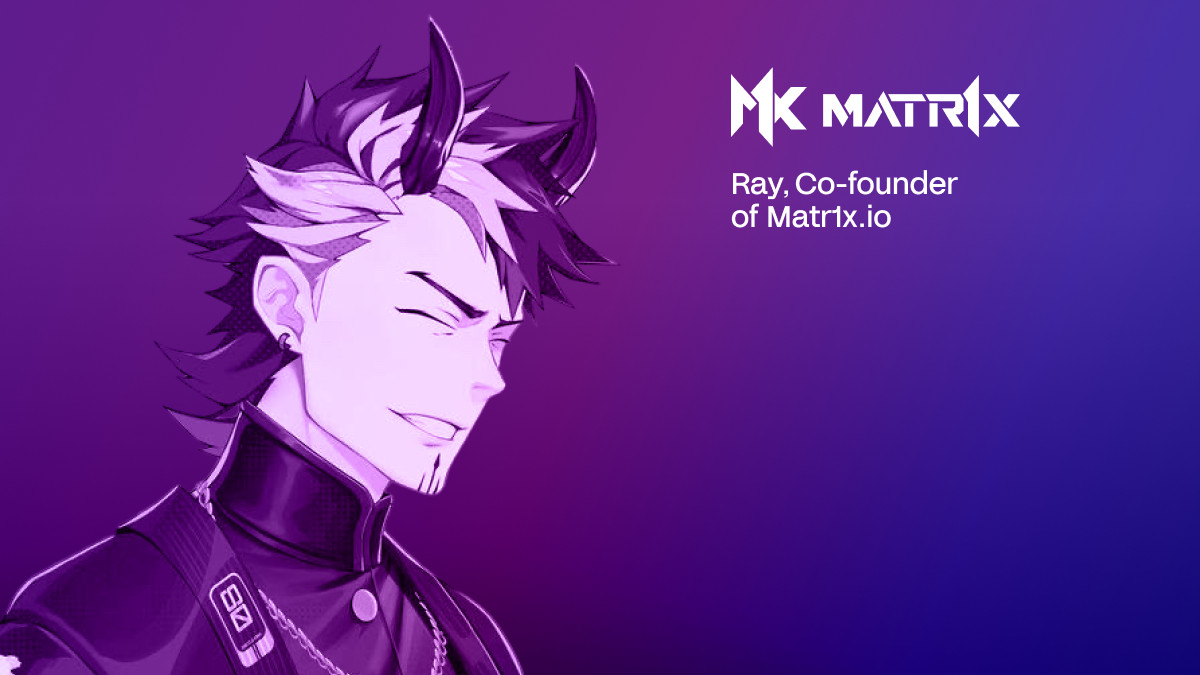[ad_1]


In Brief
Ray, Co-founder of Matr1x.io, explores Web3 gaming in Asia, comparing it to Western markets and examining the intersection of blockchain, AI, and traditional gaming sectors.

In this interview, Ray, Co-founder of Matr1x.io, delves into the intricate world of Web3 gaming in Asia. Zhao offers a comprehensive perspective on the unique challenges and opportunities, comparing Asian markets with their Western counterparts and exploring the intersection of blockchain, artificial intelligence, and traditional gaming sectors.
How does Web3 gaming in Asia differ from regions like Europe and America?
There are significant differences in the types of games played in Asia compared to Europe and the US. In Asia, mobile gaming is dominant, with revenues about twice that of PC and console games combined. For example, games like Free Fire and PUBG Mobile have announced 150 million and 100 million daily active users worldwide, respectively.
In Asia, there’s a strong focus on mobile games due to economic factors. Even in Japan, while players enjoy both mobile and PC/console games, mobile is still very popular. In contrast, US gamers tend to prefer PC and console games.
The challenge for Web3 games, especially AAA titles, is that major PC platforms like Steam and Xbox are resistant to blockchain games. Epic Games Store is more open but has a smaller market share. This makes user acquisition difficult and expensive for PC-based Web3 games.
Mobile games, on the other hand, can acquire users more cheaply through platforms like Facebook and Google. This is why many Korean and Japanese studios are focusing on mobile games. The revenue from mobile games in Asia far exceeds that of console and PC games.
Currently, it’s challenging for us to gain recognition in the US and Europe. However, once players can try our games during public testing, they’ll see that we offer quality comparable to PUBG Mobile or Free Fire. This might change perceptions about the effort we’re putting into delivering a high-quality product.
What are the challenges preventing further adoption of Web3 gaming and mobile gaming?
Web3 game companies need to build both games and blockchain infrastructure. Any small mistake in the blockchain infrastructure can be catastrophic for the entire project, damaging its credibility. With numerous hackers around, there’s zero room for error. This places high demands on blockchain teams.
The number of Web3 gamers has declined since the Axie Infinity peak, and there aren’t many popular Web3 games consistently onboarding new users. Web3 gamers are currently fewer in number than traders. For our game, we believe we can onboard Web3 users through eSports and streaming, as shooting games are very popular on platforms like YouTube.
The challenge lies in how Web2 users can pay for weapon assets. Currently, you can buy NFTs through iOS using fiat currencies, as regulations on NFTs are less strict than on tokens. We’re working on a network where people can buy crypto assets using fiat currencies, similar to Web2 users.
If a platform like Steam could solve the key problems of marketing, infrastructure, and payment, many Web3 game studios could successfully enter the market and monetize their games.
How has the demographic of Web3 gaming players and viewers in Asia changed with the implementation of blockchain in gaming?
The situation varies greatly across different Asian countries. In countries like Malaysia, Indonesia, Thailand, and the Philippines, where average monthly incomes are around $200, people are very interested in games that can improve their daily income. Even earning a few dollars a day from a Web3 game is attractive to them.
However, in countries like Japan, Taiwan, and Korea, where incomes are higher and people are well-educated, the motivation is different. They’re less interested in play-to-earn for small amounts of money. Instead, many are artists who want to create assets for games. We’re developing an asset editor to enable this kind of creative economy, which is more appealing in these higher-income areas.
What role do cultural attitudes towards gaming and cryptocurrency play in the acceptance of Web3 sports and gaming across different Asian regions?
Cultural differences significantly influence gamer behavior across Asian countries. For instance, in Taiwan, MMORPG and strategy games are the most popular, with mobile and FPS games ranking third or fourth. In Thailand, however, FPS (shooting games) are the most popular, followed by mobile games, with both categories being popular for esports.
The acceptance of Web3 in esports depends more on the game’s quality, balance, and graphics than whether it’s Web3 or Web2. In Thailand, many people know our game, and a lot of them come from Web2. The primary focus is on creating exciting content and fostering competition.
What sets Web3 esports apart is the ability to co-create assets with teams and hosts, sharing revenue from these assets. This open approach allows us to involve all partners who contribute to the esports ecosystem, providing them with ongoing revenue from NFT trading royalties.
How are traditional Asian gaming giants adapting their businesses to the new adoption of blockchain and Web3 gaming?
The situation varies by country due to different regulations. In China, it’s forbidden due to restrictions on cryptocurrencies like Bitcoin and Ethereum. However, in Japan, Korea, and Vietnam, many game studios are building Web3 games.
The approach often depends on the vision of the company’s founders or CEO. In Korea, while trading cryptocurrencies is illegal, companies are finding ways to develop Web3 games legally. In Japan and Vietnam, licenses are available for legal operation.
Many major companies are investing in blockchain technologies. In Korea, companies like VSPN are involved. In Japan, giants like Sony, Line, and Square Enix are investing in blockchain technologies, with many focusing on stablecoins and chains supported by networks like Particle Network.
How are gaming platforms using artificial intelligence for their solutions and gaming experiences?
I’ve observed many amazing innovations in AI. I believe the entire industry and management structure will recognize AI as the next major driver. Currently, we have different plans for AI implementation. Firstly, we aim to empower communities to create weapon skins easily. With AI-generated content (AIGC), users can incorporate beautiful images into weapons, creating their own unique skins.
This presents a significant opportunity and innovation for us, as weapon and avatar skins are our game’s main revenue sources. We plan to share this revenue with the community, which people will likely see by the end of this year.
Secondly, AI players and NPCs are crucial in the gaming industry, especially for shooting games. It’s important that AI bots play so well that they’re indistinguishable from real humans. This is an area where all game companies should invest.
Lastly, we’ll use AI technologies to strengthen our anti-cheating mechanisms. This is particularly important for Web3 games, where cheaters can significantly impact the game’s economy. Our AI-based anti-cheating program will serve as infrastructure for our platform and support our invested games.
Are there any other trends or new technologies that can be useful for Web3 gaming?
In my opinion, blockchain and AI are the two major trends for Web3 games, and they’re just getting started. If we’re talking about a third trend, I’d say it’s VR and AR technologies. I’ve experienced VR, and it’s truly amazing. Many people are discussing 3D content, which is a step beyond the 2D content we’re currently playing and watching.
For our company, we have strategies in place. Our Web3 assets can be used across multiple games, and we have experience building AR and VR games. It’s relatively easy for a shooting game company to adapt their user interface for VR. I believe the Metaverse is the ultimate goal for World of Arcade companies, though widespread adoption of VR headsets may take about ten years.
How do you foresee the development of Web3 gaming in Asia and the West in the next three years?
I’ve been to Dubai many times and can sense the atmosphere in parts of the West, but I haven’t been to Europe or the US for many years. From my perspective, regulation is the most crucial factor. Regulations in the US and Europe are quite strict. I hope that if there’s a change in leadership, new regulations might allow users to truly enjoy NFTs.
As for Asia, I think it’s an excellent place for Web3 gamers. There are numerous projects and Web3 studios continuously investing in high-quality Web3 games. In the next two to five years, we’ll likely see many high-quality Web3 games emerge.
The market includes wealthy individuals from Japan, Korea, and Taiwan, as well as many people in South Asia looking to earn money. With a population of two billion in South Asia, it’s a large enough market for a company to grow their product. However, it’s challenging to build a truly popular game for low-quality Android phones. Despite this, I believe the Asian market is ideal for mobile Web3 gaming.
Disclaimer
In line with the Trust Project guidelines, please note that the information provided on this page is not intended to be and should not be interpreted as legal, tax, investment, financial, or any other form of advice. It is important to only invest what you can afford to lose and to seek independent financial advice if you have any doubts. For further information, we suggest referring to the terms and conditions as well as the help and support pages provided by the issuer or advertiser. MetaversePost is committed to accurate, unbiased reporting, but market conditions are subject to change without notice.
About The Author
Victoria is a writer on a variety of technology topics including Web3.0, AI and cryptocurrencies. Her extensive experience allows her to write insightful articles for the wider audience.

Victoria d’Este

Victoria is a writer on a variety of technology topics including Web3.0, AI and cryptocurrencies. Her extensive experience allows her to write insightful articles for the wider audience.
[ad_2]
Read More: mpost.io










 Bitcoin
Bitcoin  Ethereum
Ethereum  Tether
Tether  XRP
XRP  Solana
Solana  USDC
USDC  TRON
TRON  Dogecoin
Dogecoin  Lido Staked Ether
Lido Staked Ether  Cardano
Cardano  Wrapped Bitcoin
Wrapped Bitcoin  Hyperliquid
Hyperliquid  Wrapped stETH
Wrapped stETH  Bitcoin Cash
Bitcoin Cash  Sui
Sui  Chainlink
Chainlink  LEO Token
LEO Token  Stellar
Stellar  Avalanche
Avalanche  Toncoin
Toncoin  USDS
USDS  WhiteBIT Coin
WhiteBIT Coin  Shiba Inu
Shiba Inu  WETH
WETH  Wrapped eETH
Wrapped eETH  Litecoin
Litecoin  Binance Bridged USDT (BNB Smart Chain)
Binance Bridged USDT (BNB Smart Chain)  Hedera
Hedera  Monero
Monero  Ethena USDe
Ethena USDe  Polkadot
Polkadot  Bitget Token
Bitget Token  Coinbase Wrapped BTC
Coinbase Wrapped BTC  Uniswap
Uniswap  Pepe
Pepe  Pi Network
Pi Network  Aave
Aave  Dai
Dai  Ethena Staked USDe
Ethena Staked USDe  OKB
OKB  Bittensor
Bittensor  BlackRock USD Institutional Digital Liquidity Fund
BlackRock USD Institutional Digital Liquidity Fund  Cronos
Cronos  Aptos
Aptos  Internet Computer
Internet Computer  NEAR Protocol
NEAR Protocol  Jito Staked SOL
Jito Staked SOL  sUSDS
sUSDS  Ethereum Classic
Ethereum Classic